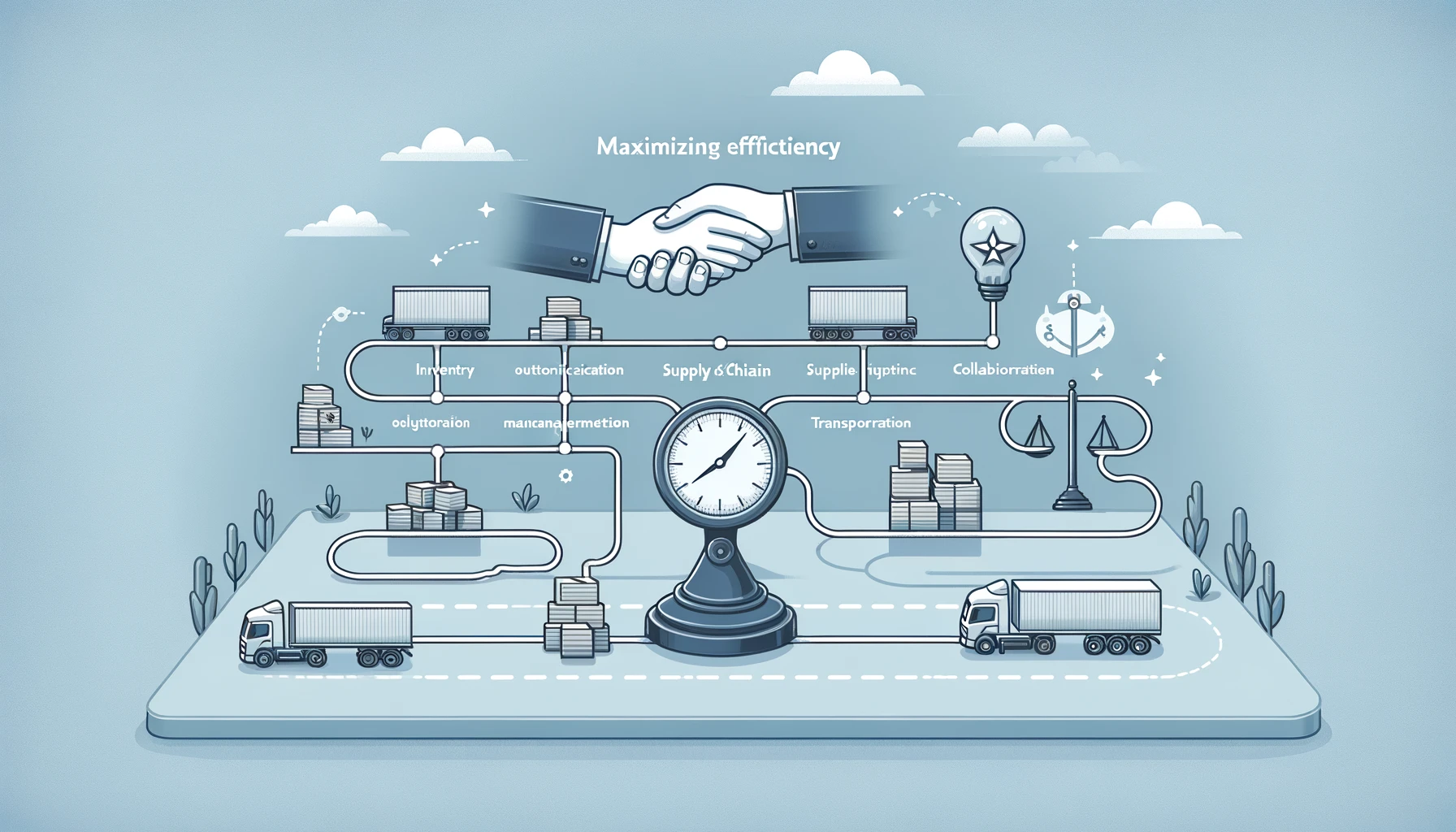Supply Chain Strategy: Key Steps to Optimize Operations

Master supply chain strategy to streamline operations, reduce costs, and enhance efficiency. Explore our actionable insights.
Streamlining Your Operations with Effective Management
In today’s competitive landscape, a robust supply chain strategy is a cornerstone of business success. Streamlining operations is not just about cutting costs—it’s about enhancing overall efficiency, increasing speed, and delivering value to your customers. Here’s how you can refine your approach for more effective management.
Prioritize Demand Planning: Start by forecasting demand accurately. This is crucial for aligning inventory with customer needs and avoiding excess or shortages.
Optimize Procurement: Forge strong relationships with suppliers and develop a procurement system that’s both cost-effective and reliable.
Innovate Manufacturing: Leverage lean manufacturing techniques to minimize waste and maximize productivity.
Logistics Synergy: Integrate logistics with your supply chain strategy to ensure timely delivery and lower transportation costs.
Leverage Technology: Implement AI tools for business to automate processes and improve decision making.
Continuous Improvement: Adopt a culture of continuous improvement, using data to refine and evolve your strategy.
To visualize the impact of a well-executed supply chain strategy, consider the following table:
| Metric | Before Implementation | After Implementation | Improvement |
|---|---|---|---|
| Order Processing Time (hours) | 24 |
8 |
-66% |
| Order Error Rate (%) | 10 |
2 |
-80% |
| Customer Satisfaction Score (out of 10) | 7 |
9 |
+28.6% |
| Inventory Management Efficiency (%) | 65 |
90 |
+38.5% |
Furthermore, compare features of popular ERP AI solutions to find the best fit for your operations:
| Feature | Ozma | Zoho | Odoo |
|---|---|---|---|
| Real-time Inventory Tracking | ✓ | ✓ | x |
| Supplier Performance Analytics | ✓ | x | ✓ |
| Automated Replenishment | ✓ | ✓ | x |
| Integrated Logistics Management | ✓ | x | ✓ |
| Advanced Forecasting Tools | ✓ | x | x |
By adhering to these strategies and utilizing the right technology, you can achieve a leaner, more responsive supply chain.

Remember, the goal is not only to reduce costs but also to deliver value that distinguishes your brand in the marketplace.
The Cornerstones of a Robust Logistics Framework
In the realm of optimizing your supply chain strategy, establishing a robust logistics framework is key. This framework serves as the backbone of your supply chain, ensuring that products are delivered efficiently and reliably. To build this strong foundation, focus on the following cornerstones:
Integrated Planning and Execution: Align your transportation, distribution, and fulfillment activities. This integration ensures that logistics operations support one another, leading to a smoother flow of goods.
Technology Integration: Harness the power of integrated business solutions like a Transportation Management System (TMS) to gain visibility and control over your logistics operations.
Flexibility and Scalability: Your logistics framework should be able to adapt to fluctuating market demands and scale with your business growth.
Risk Management: Implement strategies to mitigate risks such as delays, damages, and unexpected costs. This includes diversifying your carrier mix and planning for contingencies.
Sustainability Initiatives: Incorporate eco-friendly practices, like optimizing routes to reduce fuel consumption, which can save costs and improve your brand image.
Strategic Partnering: Forge lasting partnerships with logistics providers who understand your business and can offer value-added services.
To underline the importance of these cornerstones, here’s a comparison of different logistics attributes before and after optimizing your framework:
| Logistics Attribute | Before Optimization | After Optimization | Impact |
|---|---|---|---|
| Delivery Lead Time | Longer | Reduced | Improved customer satisfaction |
| Cost Efficiency | Low | High | Enhanced profitability |
| Flexibility | Rigid | Adaptive | Greater market responsiveness |
| Risk Exposure | High | Managed | Lower operational disruptions |

By focusing on these cornerstones, you strengthen your logistics, which is a critical component of your overall supply chain strategy. A well-structured logistics framework not only supports current operations but also paves the way for future growth and success.
Maximizing Efficiency Through Strategic Planning
A well-defined supply chain strategy is the heartbeat of any thriving enterprise. It’s the blueprint for navigating the complexities of today’s global market. As you dive into strategic planning, keep efficiency at the forefront. Here’s how to maximize it:
Inventory Optimization: It’s a delicate balance to maintain the right inventory levels. Too much can lead to high holding costs, while too little can result in stockouts and lost sales. Employ advanced forecasting and inventory management tools to strike the perfect balance.
Supplier Collaboration: Your supply chain is only as strong as its weakest link. Collaborate closely with suppliers to create a seamless flow of materials, ensuring reliability and quality.
Transportation Management: Opt for multi-modal transportation strategies to reduce costs and improve delivery times. A mix of transport options can provide flexibility and resilience against disruptions.
Process Automation: Automation can significantly cut down time-consuming manual tasks. Integrate AI task managers to streamline operations from procurement to shipping.
Performance Metrics: Establish clear KPIs to measure the effectiveness of your supply chain strategy. This will help you identify areas for improvement and celebrate successes.
To help illustrate the benefits of strategic planning, consider this comparison chart:
| Benefits of Strategic Planning | Impact on Supply Chain |
|---|---|
| Enhanced Efficiency | Streamlined operations |
| Cost Reduction | Lower operational expenses |
| Improved Supplier Relations | Stronger supply network |
| Increased Customer Satisfaction | Higher loyalty and retention |

By embracing these principles, your company can not only navigate the intricacies of the supply chain but also emerge as a leader in operational efficiency. Remember, strategic planning is not a one-time event—it’s an ongoing process that evolves with your business and the market. Embrace the journey to a leaner, more efficient, and customer-focused supply chain.
Harnessing the Power of Coordination and Collaboration
A successful supply chain strategy hinges on the seamless coordination and collaboration across all its facets. Whether it’s synchronizing with suppliers or aligning with logistics partners, the synergy created through collaborative efforts is a force multiplier for operational excellence. Here’s how to tap into this power:
Shared Goals and Vision: Ensure that everyone in the supply chain is working towards the same objectives. This unity fosters a collaborative environment where each member is committed to the collective success.
Communication Channels: Establish open and effective communication channels. Regular updates, meetings, and technology platforms can facilitate the exchange of vital information.
Collaborative Technology: Invest in technologies that support collaboration, such as cloud-based CRM for sales and ERP AI chatbots, which can bridge the gap between different supply chain segments.
Joint Problem-Solving: Encourage a culture where sharing challenges and working together to find solutions is the norm. This approach leads to innovative ideas and strengthens partnerships.
Trust and Transparency: Build trust through transparency in operations. Sharing data and insights not only improves efficiency but also fosters a sense of ownership and responsibility among all parties.
Performance and Reward Alignment: Align incentives with performance metrics that encourage collaboration. This ensures that all parties are equally invested in achieving the best outcomes.
To emphasize the importance of coordination and collaboration, observe this simple chart:
| Collaboration Aspect | Benefits |
|---|---|
| Unified Vision | Cohesive strategy execution |
| Open Communication | Faster problem resolution |
| Integrated Technology | Streamlined information flow |
| Collective Problem-Solving | Innovative solutions |
| Trust and Transparency | Stronger partnerships |
| Aligned Incentives | Shared success |

Embracing coordination and collaboration is not just about managing the supply chain—it’s about elevating it to new heights of performance. By working together, your company can achieve a robust and resilient supply chain that is prepared to meet today’s demands and adapt to tomorrow’s challenges.
With these strategies in place, your supply chain becomes more than just a series of steps; it becomes a dynamic ecosystem that thrives on the collective effort of its parts. This is the essence of a modern, effective supply chain strategy.
Navigating the Complexities of Modern Commerce
In the fast-paced world of modern commerce, navigating the complexities of a supply chain strategy can be daunting. However, with the right approach, you can turn these challenges into opportunities for growth and innovation. The key lies in understanding the intricate web of global markets, diverse customer needs, and rapidly evolving technologies.
Adapting to Global Market Trends: Keep a finger on the pulse of global market shifts. From geopolitical changes to economic fluctuations, staying informed helps you anticipate and respond swiftly to external factors that impact your supply chain.
Meeting Diverse Customer Demands: Today’s consumers expect personalized experiences and rapid fulfillment. Tailor your supply chain to offer a range of products and delivery options that cater to these varied preferences.
Embracing Technological Advances: The digital revolution has brought forth tools like blockchain, IoT, and big data analytics. These can provide unprecedented visibility and precision in your supply chain operations.
Building Resilience against Disruptions: Create contingency plans to safeguard against supply chain disruptions. This resilience is critical in maintaining operations amidst unforeseen events.
Sustainable Practices: Integrate sustainability into your supply chain strategy. Ethical sourcing and green logistics are not only good for the planet but also resonate with eco-conscious consumers.
Collaboration with Stakeholders: Foster strong relationships with all stakeholders, from suppliers to customers. Collaboration leads to a more agile and responsive supply chain.
To illustrate the importance of a flexible and adaptive approach, let’s look at a simple chart:
| Modern Commerce Challenge | Strategic Response |
|---|---|
| Global Market Volatility | Agile decision-making |
| Consumer Demand Diversity | Customization and speed |
| Technological Disruption | Continuous innovation |
| Supply Chain Disruptions | Robust contingency planning |
| Sustainability Requirements | Eco-friendly operations |
| Stakeholder Expectations | Collaborative engagement |

By mastering these strategies, you can ensure that your supply chain is not just surviving but thriving in the complexities of modern commerce. Each step you take to optimize your supply chain brings you closer to delivering exceptional value to your customers and staying ahead in the competitive market.
FAQs
What is a supply chain strategy?
A supply chain strategy defines how a company manages the flow of goods, information, and finances to optimize efficiency and meet customer demand.
How can a supply chain strategy improve my business?
It can streamline operations, reduce costs, enhance customer satisfaction, and increase competitiveness in the market.
What are the components of an effective supply chain strategy?
Key components include demand planning, procurement, manufacturing, logistics, and continuous improvement practices.
Can technology improve supply chain management?
Yes, technology like AI, IoT, and blockchain can greatly enhance visibility, efficiency, and accuracy in supply chain management.
How often should a supply chain strategy be reviewed?
It should be regularly reviewed and adapted to align with changing market conditions, technology advancements, and business goals.
Read more about low-code platform ozma.io
What Is Supply Chain Strategy? Key Principles Explained
Strategic Supply Chain Optimization Techniques

